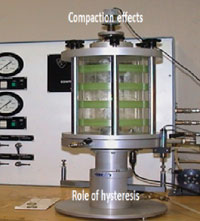Fundamental Acoustic Behavior of Soils
 Soil is the controlling interface of the Critical Zone (CZ), defined as the Earth’s boundary layer from the vegetation canopy to the aquifer bottom. This interface is not only the media for food and fiber production but controls the exchange of nutrients and contaminates between the atmosphere, surface waters and ground waters as well as the storage and biochemical transformations of those chemicals. Soil is highly complex and spatially variable. Typical soil profiles are comprised of layers with distinct soil properties. It is these layers that define a soil and its impact on the CZ.
Soil is the controlling interface of the Critical Zone (CZ), defined as the Earth’s boundary layer from the vegetation canopy to the aquifer bottom. This interface is not only the media for food and fiber production but controls the exchange of nutrients and contaminates between the atmosphere, surface waters and ground waters as well as the storage and biochemical transformations of those chemicals. Soil is highly complex and spatially variable. Typical soil profiles are comprised of layers with distinct soil properties. It is these layers that define a soil and its impact on the CZ.
Less invasive and more field expedient techniques has led to the investigation of several high resolution geophysical methods for studying soil properties. The tradeoff associated with using geophysical and remote sensing techniques is that the measurements are sensitive to the distribution of the bulk “geophysical” properties and relationships between these properties and the more “basic” properties must be determined.
The goal of this research is to determine the relationship between acoustic properties of soils and more traditional properties during various physical processes such as compaction and weathering.